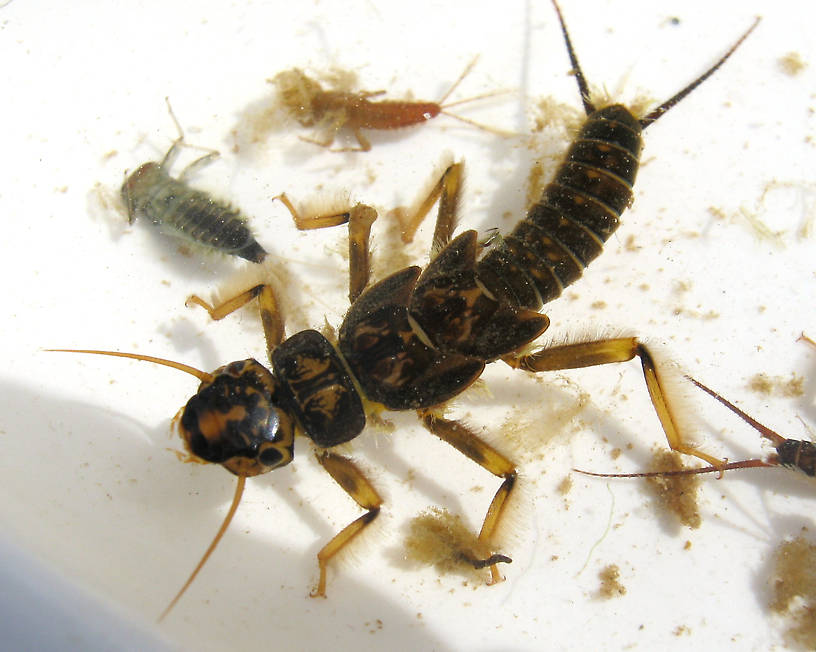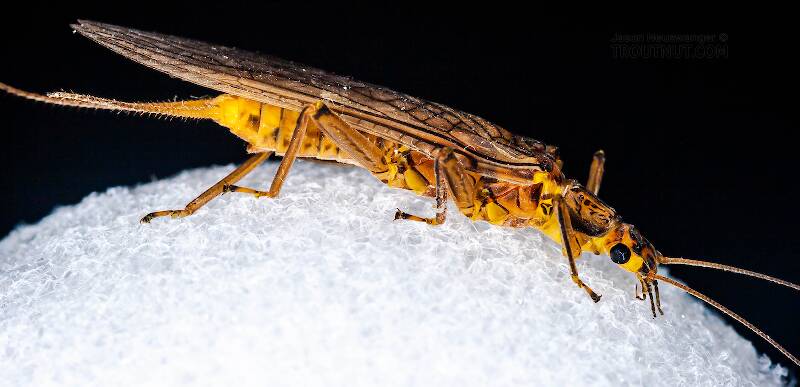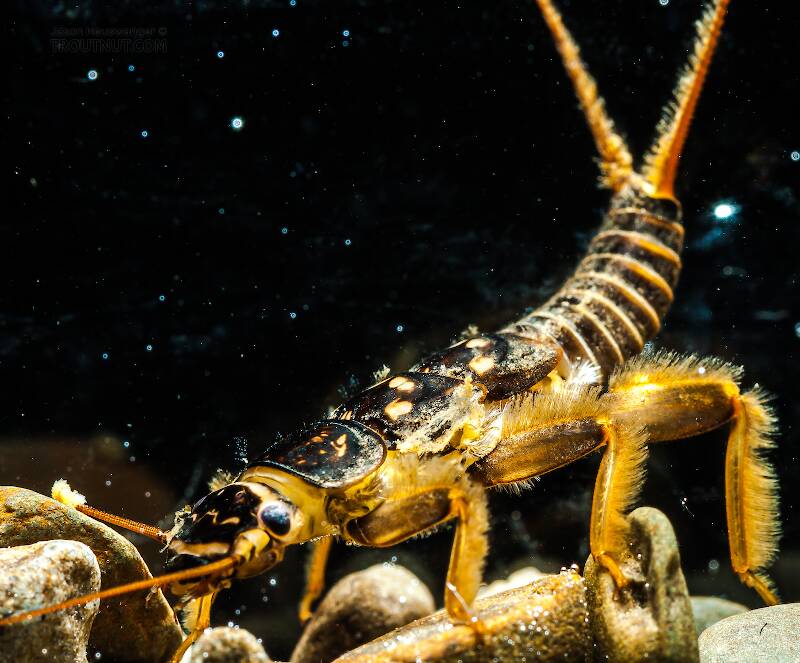
Hex Mayflies
Hexagenia limbata
The famous nocturnal Hex hatch of the Midwest (and a few other lucky locations) stirs to the surface mythically large brown trout that only touch streamers for the rest of the year.
Featured on the forum

This one was surprisingly straightforward to identify. The lack of a sclerite at the base of the lateral hump narrows the field quite a bit, and the other options followed fairly obvious characteristics to Clostoeca, which only has one species, Clostoeca disjuncta.

Troutnut is a project started in 2003 by salmonid ecologist Jason "Troutnut" Neuswanger to help anglers and
fly tyers unabashedly embrace the entomological side of the sport. Learn more about Troutnut or
support the project for an enhanced experience here.
Golden Stones
Like most common names,"Golden Stone" can refer to more than one taxon. They're previewed below, along with 4 specimens. For more detail click through to the scientific names.
Stonefly Family Perlidae
These are often called Golden Stones.
Every angler who turns over a rock now and then is familiar with the stout bodied and hastily scurrying examples of the family Perlidae. They are very active and predaceous. This family contains most of the large stonefly species common to freestone streams across the continent. There are fifteen genera of this large and abundant family currently recognized in North America. They are easy to tell from Pteronarcyidae species (Eastern Giant Black Stonefly, Western Salmonfly) by their lighter, patterned coloration. They are also much more ovoid in cross section. Their longer tails/antennae and large triangular heads are other 'easy to spot' differences. The males are substantially smaller than the females and some have very short wings.
Perlidae species are very similar in conformation and habits. With some exceptions, telling them apart can be very difficult East of the Rockies where ten of the genera reside and more than 50 species are involved. With nymphs, differentiating them by subfamily is a good place to start. There are only two: Perlinae - those with an occipital ridge and row of spinules (often making the back of their heads look concave); Acroneuriinae - those without an occipital ridge or row of spinules. See the genus and species pages for more information.
Angling literature can be confusing as species of this family were historically referred to as Golden Stoneflies on the West Coast, Brown Willowflies in the Rockies, and in the East they went by a plethora of names. Stone Creeper, American Stonefly, and Common Stonefly were used for the more abundant and usually more somber hued subfamily Acroneuriinae; also present are many often colorful species of the subfamily Perlinae that go by equally colorful names like Yellow Legged Stonefly, Embossed Stonefly, and Beautiful Stonefly. Over time these regional names are going by the wayside as more and more anglers (and the latest angling literature) refer to all of them collectively as Golden Stoneflies.
The nymphs range in coloration from dark brown, delicately patterned gold and amber, to a brilliant yellow and black striped pattern reminiscent of Bengal tigers. The latter description befits them in recognition of their predator status. Their rarely abundant populations and nocturnal habits make them limited in importance back East, but out West, the story is quite different.
In the Rocky Mountain and Pacific Coast States, perlids exist in tremendous numbers and perhaps more importantly, they are very active during daylight hours. Ironically, in spite of the large populations the entire family is represented by only eight species in six genera and of those, by far the largest populations involve only two, Calineuria californica and the equally common Hesperoperla pacifica. Certain characteristics allow the angler to easily tell these western species apart in the hand by comparing head markings and the presence or absence of anal gills on the nymphs. The adults are easily sorted as well by knowing the different hammer shapes of the males and dorsal markings of both sexes.
Taxonomic revisions have moved four of the five western species formerly classified under Acroneuria to new genera, though like the two already mentioned, they are easily recognized in the taxa lists by their retained species names. All remaining Acroneuria species are now east of the Rockies.
Perlidae species are very similar in conformation and habits. With some exceptions, telling them apart can be very difficult East of the Rockies where ten of the genera reside and more than 50 species are involved. With nymphs, differentiating them by subfamily is a good place to start. There are only two: Perlinae - those with an occipital ridge and row of spinules (often making the back of their heads look concave); Acroneuriinae - those without an occipital ridge or row of spinules. See the genus and species pages for more information.
Angling literature can be confusing as species of this family were historically referred to as Golden Stoneflies on the West Coast, Brown Willowflies in the Rockies, and in the East they went by a plethora of names. Stone Creeper, American Stonefly, and Common Stonefly were used for the more abundant and usually more somber hued subfamily Acroneuriinae; also present are many often colorful species of the subfamily Perlinae that go by equally colorful names like Yellow Legged Stonefly, Embossed Stonefly, and Beautiful Stonefly. Over time these regional names are going by the wayside as more and more anglers (and the latest angling literature) refer to all of them collectively as Golden Stoneflies.
The nymphs range in coloration from dark brown, delicately patterned gold and amber, to a brilliant yellow and black striped pattern reminiscent of Bengal tigers. The latter description befits them in recognition of their predator status. Their rarely abundant populations and nocturnal habits make them limited in importance back East, but out West, the story is quite different.
In the Rocky Mountain and Pacific Coast States, perlids exist in tremendous numbers and perhaps more importantly, they are very active during daylight hours. Ironically, in spite of the large populations the entire family is represented by only eight species in six genera and of those, by far the largest populations involve only two, Calineuria californica and the equally common Hesperoperla pacifica. Certain characteristics allow the angler to easily tell these western species apart in the hand by comparing head markings and the presence or absence of anal gills on the nymphs. The adults are easily sorted as well by knowing the different hammer shapes of the males and dorsal markings of both sexes.
Taxonomic revisions have moved four of the five western species formerly classified under Acroneuria to new genera, though like the two already mentioned, they are easily recognized in the taxa lists by their retained species names. All remaining Acroneuria species are now east of the Rockies.
See 45 more specimens...
Stonefly Species Hesperoperla pacifica
These are very rarely called Golden Stones.
This species is perhaps better known by anglers under its former scientific name, Acroneuria pacifica. On many rivers they share the same hatching cycle with the famous Pteronarcys californica (Salmonfly) that often overshadows them. Both can be found on the water at the same time in tremendous numbers. Anglers can become so mesmerized by the size and legend of the famous Salmonflies that they fail to pay attention to the smaller and more somber Perlidae. Rest assured the trout don't make that mistake. It pays to keep an eye out for which species the fish are most interested in on a particular stretch or run. Many boulders streamside can be covered with the empty husks of both species intermixed. See the Perlidae Hatch Page for more information.
Older anglers with an extensive background fishing in the Rockies often refer to them as Brown Willowflies or simply "Willows". Historically, Golden Stonefly was a name used on the West Coast to describe members of the family Perlidae (it seems everything from California was gold back then). While in the Rockies, Willow fly was the common name settlers and ranchers used. Over time, the most prominent species on the coast, Calineuria californica became universally accepted in angling literature as the Golden Stone, while Hesperoperla pacifica as the most prominent species in the Rockies was usually listed as Brown Willowfly. In 1955 in Matching the Hatch, Ernest Schwiebert wrote that this species is partially responsible for the "willowfly" hatches of the West, and he described some Colorado mating flights as "really a spectacle to see." Even late into the '80's popular angler entomologies such as Rick Hafele's "Western Hatches" made this distinction. The name Willowfly has largely been dropped from the lexicon of the latest generation of anglers, at least when referring to this species. In an interesting twist of irony, it is Hesperoperla pacifica that now bears the scientific common name Golden Stonefly - not Calineuria californica.
The nymphs have prominent anal gills making them easy to tell apart from Calineuria. They are also often less dramatically marked and have an hour glass or similar shaped mark running vertically on the front of their heads. The more somber appearance holds true for the adults as well. The male adults of Calineuria and Hesperoperla are easier to tell apart by looking at their hammers. Both are quadrangular but Hesperoperla is wider than long.
Older anglers with an extensive background fishing in the Rockies often refer to them as Brown Willowflies or simply "Willows". Historically, Golden Stonefly was a name used on the West Coast to describe members of the family Perlidae (it seems everything from California was gold back then). While in the Rockies, Willow fly was the common name settlers and ranchers used. Over time, the most prominent species on the coast, Calineuria californica became universally accepted in angling literature as the Golden Stone, while Hesperoperla pacifica as the most prominent species in the Rockies was usually listed as Brown Willowfly. In 1955 in Matching the Hatch, Ernest Schwiebert wrote that this species is partially responsible for the "willowfly" hatches of the West, and he described some Colorado mating flights as "really a spectacle to see." Even late into the '80's popular angler entomologies such as Rick Hafele's "Western Hatches" made this distinction. The name Willowfly has largely been dropped from the lexicon of the latest generation of anglers, at least when referring to this species. In an interesting twist of irony, it is Hesperoperla pacifica that now bears the scientific common name Golden Stonefly - not Calineuria californica.
The nymphs have prominent anal gills making them easy to tell apart from Calineuria. They are also often less dramatically marked and have an hour glass or similar shaped mark running vertically on the front of their heads. The more somber appearance holds true for the adults as well. The male adults of Calineuria and Hesperoperla are easier to tell apart by looking at their hammers. Both are quadrangular but Hesperoperla is wider than long.

My blurry photo at first makes it look like there might be a distinct notch in the subgenital plate of this specimen, but that's not the case -- just a poor photo. That's important to the ID.

This monster started to feed within a few minutes of sharing the inspection tray with its victims. This nymph is a voracious predator of small invertebrates and has even been noted for feeding on small fish and salmonid alevins. The niche it fills in fast water is equivalent to the Dragonfly nymphs that inhabit slower water.
Hesperoperla pacifica nymphs are easily distinguished from other western perlids by the presence of anal gills (obfuscated by algae in the tray) in combination with an hour glass shaped pale mark on the front of their heads.
Hesperoperla pacifica nymphs are easily distinguished from other western perlids by the presence of anal gills (obfuscated by algae in the tray) in combination with an hour glass shaped pale mark on the front of their heads.
See 7 more specimens...
References
- Schwiebert, Ernest G. 1955. Matching the Hatch. MacMillan Publishing Company.



